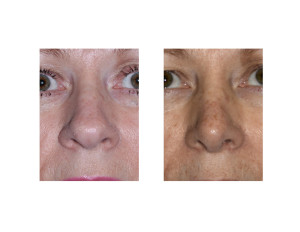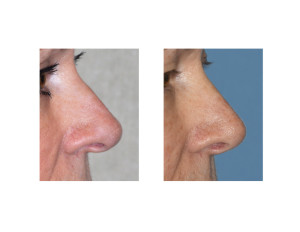Background: The shape of the nasal tip is primarily affected by its anatomic composition. The size, thickness and length of the lower alar cartilages create the major shape of the lower third of the nose. Combined with the thickness of the nasal skin over these cartilages the shape of the nasal tip is defined.
The nose is a fairly stable structure throughout one’s life being located in the very center of the face. Supported by bone and cartilage, the composition of the nose is more hard tissue than soft tissue. The rest of the face around the nose undergoes well known aging changes but the nose is less affected. But that does not mean that it does not age at all.
Numerous people feel that their nose has become ‘bigger’ as they have gotten older. Just as teeth can age as known by the historic phrase ‘long in the tooth’ (due to soft tissue gingival recession), the nose can have its own unique set of age-related changes.
Case Study: This 60 year old female has always felt she had a long nose and had wanted a rhinoplasty for some time. As she had gotten older she felt her nose has gotten longer and wider.


As people age the nose does actually become a bit longer and and the nasal tip may develop more of a droop. This is a well known phenomenon due to weakening of the nasal tip ligaments where the cartilaginous tip complex can ‘slide’ slightly off of the upper lateral cartilages and bone. This can take a nose tip that is already long and heavy to become more so. Rhinoplasty surgery can have a nose aging reversal effect with tip deprojection surgery.
Highlights:
1) The overprojecting nose that is accentuated by aging is one where the lower alar cartilages are long, creating a nasal tip that sticks out too far and may droop down.
2) Rhinoplasty for the overprojecting aging nose shortens the lower alar cartilages and brings the tip back and up. (deprojection)
3) Surgical manipulation of the lower alar cartilages also allows the width of the nasal tip to be narrowed as well.
Dr. Barry Eppley
Indianapolis, Indiana



